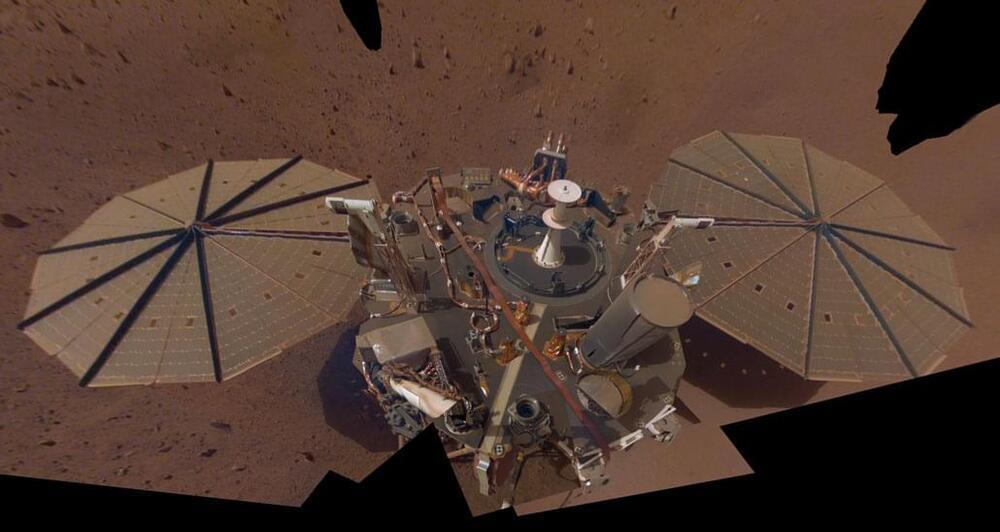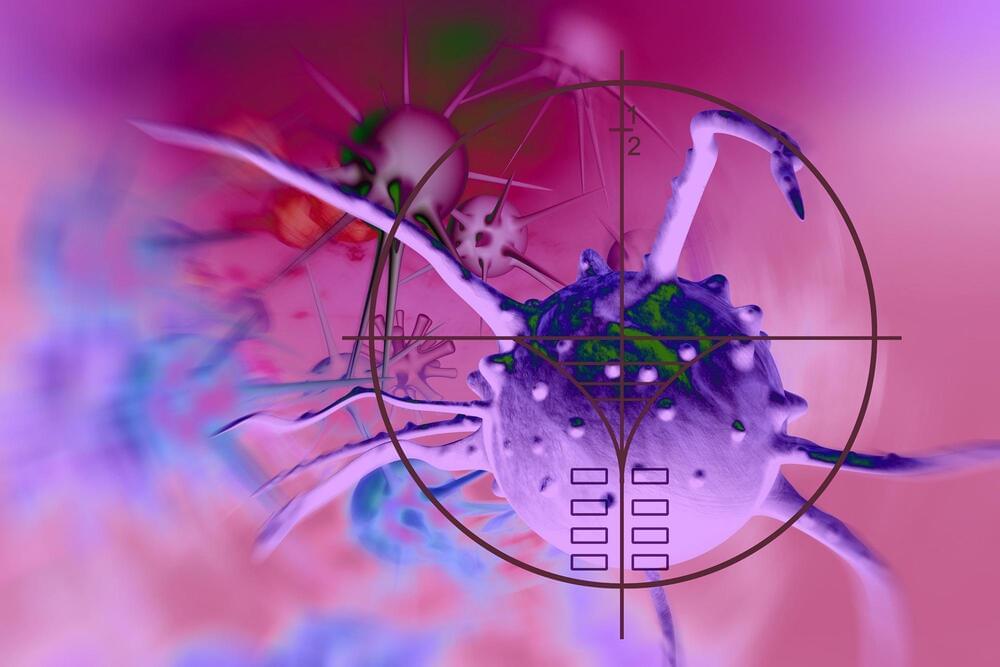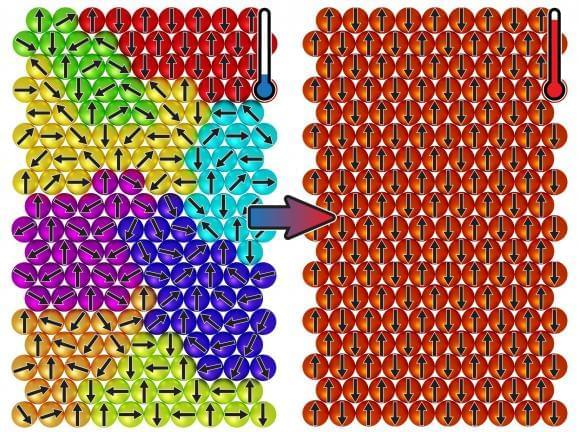Archive for the ‘materials’ category: Page 141
Jul 8, 2022
Unusual superconductivity observed in twisted trilayer graphene
Posted by Saúl Morales Rodriguéz in categories: materials, particle physics
The ability to turn superconductivity off and on with a literal flip of a switch in so-called “magic-angle twisted graphene” has allowed engineers at Caltech to observe an unusual phenomenon that may shed new light on superconductivity in general.
The research, led by Stevan Nadj-Perge, assistant professor of applied physics and materials science, was published in the journal Nature on June 15.
Magic-angle twisted graphene, first discovered in 2018, is made from two or three sheets of graphene (a form of carbon consisting of a single layer of atoms in a honeycomb-like lattice pattern) layered atop one another, with each sheet twisted at precisely 1.05 degrees in relation to the one below it. The resulting bilayer or trilayer has unusual electronic properties: for example, it can be made into an insulator or a superconductor depending on how many electrons are added.
Jul 8, 2022
Physicists discover a ‘family’ of robust, superconducting graphene structures
Posted by Saúl Morales Rodriguéz in categories: materials, particle physics
Martin ChartrandListen to the sound, more like a musket than a 3D printed plastic gun.
Second video shows the attempted assassination of former Japanese Prime Minister Shinzo Abe
NOTE: Video not graphic, but viewer discretion is advised pic.twitter.com/BZNGHP78ds
Continue reading “Physicists discover a ‘family’ of robust, superconducting graphene structures” »
Jul 7, 2022
Marsquakes reveal the Red Planet boasts a liquid core half its diameter
Posted by Alberto Lao in categories: materials, space
Mars has had its first CT scan, thanks to analyses of seismic waves picked up by NASA’s InSight lander. Diagnosis: The Red Planet’s core is at least partially liquid, as some previous studies had suggested, and is somewhat larger than expected.
InSight reached Mars in late 2018 and soon afterward detected the first known marsquake (SN: 11/26/18; SN: 4/23/19). Since then, the lander’s instruments have picked up more than a thousand temblors, most of them minor rumbles. Many of those quakes originated at a seismically active region more than 1,000 kilometers away from the lander. A small fraction of the quakes had magnitudes ranging from 3.0 to 4.0, and the resulting vibrations have enabled scientists to probe Mars and reveal new clues about its inner structure.
Simon Stähler, a seismologist at ETH Zurich, and colleagues analyzed seismic waves from 11 marsquakes, looking for two types of waves: pressure and shear. Unlike pressure waves, shear waves can’t pass through a liquid, and they move more slowly, traveling side to side through solid materials, rather than in a push-and-pull motion in the same direction a wave is traveling like pressure waves do.
Jul 7, 2022
Scientists Have Created Worms That Can Kill Cancer Cells
Posted by Kelvin Dafiaghor in categories: biotech/medical, materials
Osaka University researchers discovered that worms may be coated with hydrogel sheaths that contain useful cargo such as anti-cancer medications
James Bond’s famed quartermaster Q provided the secret agent with an unlimited supply of equipment and gadgets to aid him on his missions. Now, scientists from Japan have shown that they are equally adept in providing microscopic worms with a surprising variety of useful and protective components.
Researchers from Osaka University have discovered that microscopic, free-living worms known as nematodes may be coated with hydrogel-based “sheaths” that can be further customized to transport functional cargo.
Jul 6, 2022
Scientists baffled by magnetic material that freezes when heated up
Posted by Josh Seeherman in categories: materials, particle physics
Physicists have discovered that certain magnetic material freezes when the temperature rises to a certain point. We’ve typically only seen this behavior when we cool down magnetic materials, not when we heat them up. As such, it has left physicists scratching their heads and baffled by the development.
Physicists Alexander Khajetoorians of Radboud University in the Netherlands says that the freezing of the magnetic materials is the opposite of what we normally see. The result is “counterintuitive, like water that becomes an ice cube when it’s heated up,” according to Khajetoorians.
Normally, ferromagnetic materials like iron feature aligned spins. This means that the magnetic spins of the atoms are all spinning in the same direction. Essentially, the south and north magnetic poles are all aligned in the same direction. Some alloys made of both iron and copper, though, feature randomized spins. Physicists refer to this state as spin glass.
Jul 6, 2022
Physicists see electron whirlpools for the first time
Posted by Shubham Ghosh Roy in categories: materials, particle physics
Though they are discrete particles, water molecules flow collectively as liquids, producing streams, waves, whirlpools, and other classic fluid phenomena.
Not so with electricity. While an electric current is also a construct of distinct particles—in this case, electrons —the particles are so small that any collective behavior among them is drowned out by larger influences as electrons pass through ordinary metals. But, in certain materials and under specific conditions, such effects fade away, and electrons can directly influence each other. In these instances, electrons can flow collectively like a fluid.
Now, physicists at MIT and the Weizmann Institute of Science have observed electrons flowing in vortices, or whirlpools—a hallmark of fluid flow that theorists predicted electrons should exhibit, but that has never been seen until now.
Jul 5, 2022
Magnetic spins that ‘freeze’ when heated: nature in the wrong direction
Posted by Dan Breeden in categories: materials, particle physics
Physicists observed a strange new type of behaviour in a magnetic material when it’s heated up. The magnetic spins ‘freeze’ into a static pattern when the temperature rises, a phenomenon that normally occurs when the temperature decreases. They publish their findings in Nature Physics on July 4th.
The researchers discovered the phenomenon in the material neodymium, an element that they described several years ago as a ‘self-induced spin glass’. Spin glasses are typically alloys where iron atoms for example are randomly mixed into a grid of copper atoms. Each iron atom behaves like a small magnet, or a spin. These randomly placed spins point in all kinds of directions.
Unlike conventional spin glasses, where there is random mixing of magnetic materials, neodymium is an element and without significant amounts of any other material, shows glassy behavior in its crystalline form. The spins form patterns that whirl like a helix, and this whirling is random and constantly changes.
Jul 5, 2022
Ultra-low-energy programmable non-volatile silicon photonics based on phase-change materials with graphene heaters
Posted by Jose Ruben Rodriguez Fuentes in categories: energy, materials
A non-volatile silicon photonics switch based on phase-change materials actuated by graphene heaters shows a switching energy density that is within an order of magnitude of the fundamental thermodynamic limit.
Jul 3, 2022
A gentler, more precise laser cutting technique
Posted by Dan Breeden in categories: energy, materials
Laser cutting techniques are usually powered by high energy beams, so hot that they melt most materials. Now scientists from McGill University have developed a gentler, more precise technique using low-power visible light.
















